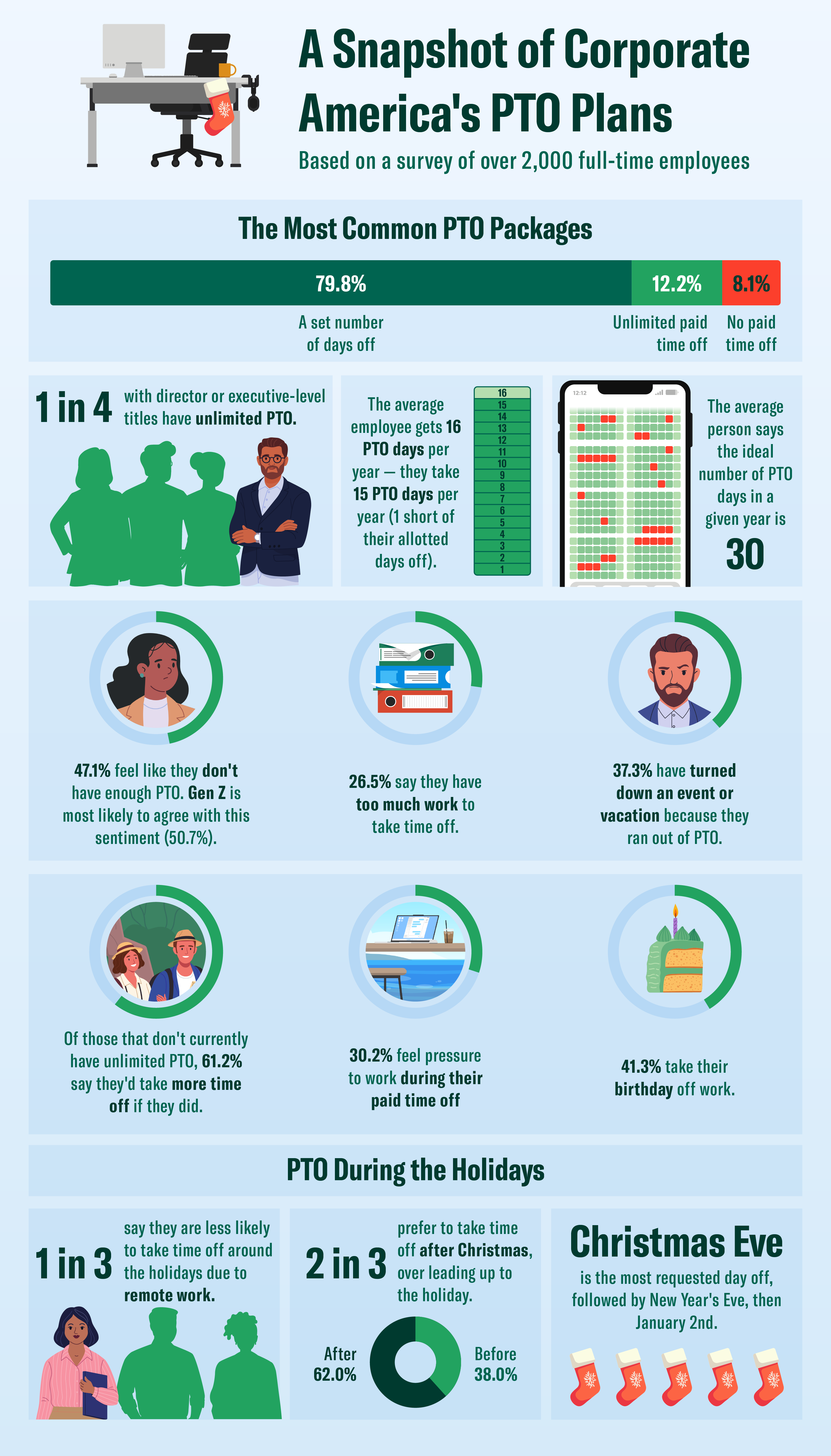As the holiday season rolls around, the pressure to stay productive doesn’t let up for everyone. For many American workers, particularly those in corporate America, taking extra time off work can be challenging. With so much riding on holiday work schedules and paid time off (PTO) policies, understanding the true sentiments around these issues can help illuminate the balancing act between career demands and personal well-being during this festive time.
To dig into these insights, we conducted a comprehensive national survey of full-time employees across various industries. By asking questions about the importance of holiday breaks, compensation expectations for working on holidays, and the willingness to trade shifts or benefits for guaranteed time off, our research aims to uncover how these attitudes differ across demographics and job sectors. These findings offer a snapshot of American workers’ preferences and provide valuable guidance for employers seeking to enhance work-life balance during the holiday season.
What Do Americans’ PTO Plans Look Like

A Breakdown of American’s Time Off Policies
PTO policies paint a revealing picture of how employers prioritize — or overlook — work-life balance. While most employees (79.8%) follow a set number of days, a lucky 12.2% benefit from unlimited PTO — a perk more common at the director and executive level, where one in four enjoy this added flexibility. The tech and communications industry leads the way in offering unlimited PTO, with 21.5% of workers enjoying this benefit, while employees in energy and transportation see the least flexibility, with just 6.4% reporting unlimited PTO options.
For those with a set number of days, the average employee receives around 16 PTO days per year, though executives tend to receive a few extra — four more days on average compared to associates. Despite this, many employees don’t take full advantage of their allotment; on average, Americans with fixed PTO policies use just 15 days annually, leaving a day’s worth of potential rest untapped. In contrast, workers with unlimited PTO take advantage of the freedom, taking 6.5% more days off than their set-PTO counterparts.
Interestingly, PTO isn’t always tied to specific plans. Two in three employees say they use their days “just because,” highlighting a desire to recharge even without a specific occasion. However, limited PTO can sometimes create a dilemma: 37.3% of workers admit to turning down an event or vacation because they had exhausted their days off, underscoring the tension between available time and personal priorities.
How Do Employees Really Feel About Their PTO Policies?
When asked about the ideal amount of time off, Americans overwhelmingly picture a more generous policy than they currently have. On average, employees would prefer 30 days of PTO annually. For those already benefiting from a higher PTO allocation of 20 or more days, the dream is even bigger — an ideal of 44 days off per year, while those with less than 10 days would be content with 23. This gap between reality and the “ideal” underscores the priority employees place on personal time and how many feel they never have enough of it.
It’s apparent that, for many American workers, their current PTO policy doesn’t quite hit the mark. Nearly half (47.1%) feel they simply don’t get enough time off, a sentiment especially strong among Gen Z workers, with 50.7% of them voicing dissatisfaction. This feeling is most pronounced in industries that rely on consistent availability, like retail, tourism, and hospitality, where 61.3% say they wish they had more PTO.
The desire for a more generous policy is clear, and unlimited PTO tops the wish list — with 68.0% of employees saying it’s their ideal setup. Women, in particular, are 14.1% more likely than men to prefer unlimited PTO, highlighting a potential area for employers to consider as they strive to meet employee expectations. The appeal of unlimited PTO isn’t just about perception, though. Workers with this perk are not only encouraged by their employers to take their time off (82.9%) but also report low rates of denied requests, with just 6.9% saying they’ve ever had a request turned down.
Despite encouragement from companies to take breaks (75.8% say their employer supports using PTO), barriers still remain. Over a quarter (26.5%) of employees feel they’re simply too busy to step away from work, while 30.2% admit feeling pressured to keep up with tasks during their time off if the rest of the company is still operating. This pressure is even more intense for directors and executives — 41.6% report working during their PTO, despite having the option to fully disconnect.
The data makes one thing clear: employees want the freedom to truly enjoy their PTO without lingering obligations, and many believe unlimited PTO might be the answer.
Taking Time Off Around the Holidays
The holiday season marks a peak in PTO usage, with the average worker dedicating 26.5% of their annual time off to November and December. This trend underscores the value of a holiday break, yet when it comes to choosing between pre- and post-Christmas time off, most (two out of three) prefer to unwind after the holiday rush, extending their celebrations and starting the new year with a bit of extra relaxation.
For many, securing time off during the holidays comes without major obstacles — 41.5% of those with unlimited PTO and 26.0% of those with set days report no barriers to taking time off. But remote work has shifted this landscape, as one in three employees feel less inclined to take time off around the holidays, citing the flexibility of working from home as a factor that impacts their PTO decisions.
When holiday work becomes unavoidable, extra pay stands out as the preferred motivator, with 52.3% of workers choosing it over rewards like additional PTO or higher year-end bonuses. Popular dates for time off highlight when Americans are most eager to disconnect, with Christmas Eve topping the list, followed closely by New Year’s Eve and January 2nd.
As the data shows, the holidays are a time when employees seek both relaxation and reward, and how companies respond can shape the season’s spirit in the workplace.
Closing Thoughts
This study sheds light on how Americans navigate their PTO policies, holiday schedules, and time-off preferences, especially in a culture where balancing work and play is key. Whether it’s the desire for unlimited PTO, the choice to take a well-earned break post-holidays, or the willingness to put in extra hours for the right rewards, it’s clear that a smart time-off strategy matters to workers across the board. That’s exactly why we dug into these insights — to help employees and employers alike understand how to strike a meaningful balance.
After all, what’s the perfect PTO plan if not a chance to make the most of life’s entertaining experiences? With a well-earned break, there’s no better time to dive into a little excitement with real-money online casino games at BetMGM. Enjoy table games, online slots, live dealer games, and more, all from the comfort of your mobile device or home computer. There’s even a generous casino welcome bonus for new player sign-ups. So, as you plan your time off, remember to savor every minute and take full advantage of those moments that make life truly thrilling.
Methodology
The data comes from an anonymous survey that ran in October of 2024. Over 2,000 full-time employees were asked about their current time-off policies, ideal schedules, and more.
